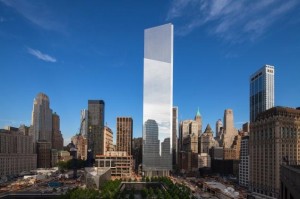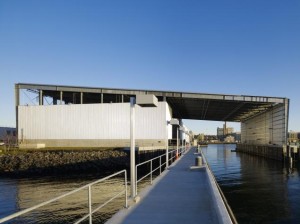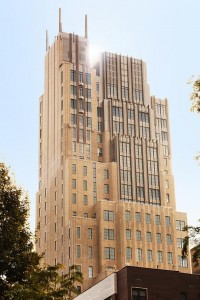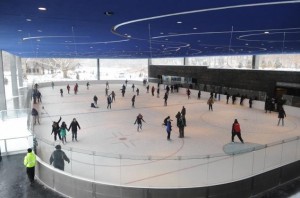Tag archives for: WTC

New York City architecture in 2013: The great and the not-so-great
In the spirit of the Olympics, here are our three favorite projects from 2013 — plus one that didn’t stick the landing.
A toast to 4 World Trade Center, Sunset Park’s new recycling center and Walker Tower, plus a hard look at Prospect Park’s new skating center.
This seems like a stretch to tie in architecture criticism to the Olympics, but it did get me to read the post by Matt Chaban of the Daily News. He brings his critique to a pedestrian level in my opinion, which is probably why I don’t know him as an architecture critic – that’s just my opinion. Do you agree with Matt’s Gold, Silver, and Bronze Medal projects? Do you have your own medals you would like to award?

Gold medal
4 World Trade Center
It may not be the biggest building on the 16-acre site, nor the boldest, but it is certainly the most beautiful — a quiet, dignified tower that honors its sacred home. Using simple geometries, Japanese master architect Fumihiko Maki put a notched parallelogram atop a trapezoid and covered the whole thing in a crystalline glass sheath. The result is a solemn sentinel watching over the site.

Silver medal
Sims recycling center
Annabelle Selldorf is best known for designing Fifth Ave. boutiques, Chelsea galleries and luxury apartments. And now a recycling plant in Sunset Park, Brooklyn (below). The firm used standard prefabricated beams and modules to create the hangar-like structure on the harbor. The surprisingly sleek industrial facility shows that simple components and a clever hand can achieve great results.

Bronze medal
Walker Tower
There’s a reason the wealthy and celebs like Cameron Diaz have been flocking to Walker Tower (right). Take a neglected art deco telephone exchange towering over Chelsea, gut it and turn it into a modern throwback. Period details and newfangled accessories are expensive, which explains why the penthouse is in contact for $50.9 million, a downtown record.

Dishonorable mention
Lakeside skating center
A good effort by Tod Williams and Billie Tsien, but the new skating center in Prospect Park (right) is more of an unpolished diamond — nice rinks, but utterly lacking in necessities like changing rooms and benches for hockey. We can only hope the problems will be addressed. By Matt Chaban
Architecture Criticism
|
4 World Trade Center, Annabelle Selldorf, architecture, design, Fumihiko Maki, Matt Chaban, Olympics, Prospect Park Skating Center, Sunset Park, Tod Williams and Billie Tsien, Walker Tower, WTC
|
Developer Larry Silverstein is said to have offered a way to to build and pay for a facility in back of the Port Authority Bus Terminal. Guess what’s in it for him.

On Tuesday, Port Authority of New York and New Jersey Executive Director Patrick Foye told a Crain’s Breakfast Forum about an idea proposed by developer Larry Silverstein to build and pay for a much-needed Manhattan bus garage. Mr. Foye called it “interesting, provocative,” but he offered no details.
A source said the idea, floated during last year’s leadership transition at the Port Authority from Christopher Ward to Mr. Foye, involves developing a site on West 39th Street and Dyer Avenue used most recently by Mercedes-Benz by the service road that funnels traffic to and from the Lincoln Tunnel just southwest of the Port Authority Bus Terminal.
Mr. Silverstein, who has a long-term letter of intent with the owner to develop that building, proposed constructing a bus garage capped by a residential tower.
Unanswered questions include how big the tower would have to be to generate sufficient income to finance the construction of the garage, and whether anyone would want to live on top of a bus garage in the heavily trafficked area. It also remains to be seen how much the Port Authority would pay.
Certainly, the idea of the Port Authority doing business again with Silverstein Properties presents political hurdles given the two entities’ complex relationship at the World Trade Center site. The developer declined to comment for this article.
On the plus side, a bus garage-cum-residential complex would solve a number of thorny logistical problems for the agency, which abandoned a bus garage development for lack of funds.
Because there’s no room inside the bus station and nowhere else to park, hundreds of New Jersey Transit buses return empty to the Garden State after dropping off morning commuters in Manhattan. They come back to the city to pick up passengers in the afternoon. A bus garage nearby would cut down on trans-Hudson River traffic, reduce air pollution and save money on fuel.
Part of the savings could be used by the Port Authority to lower terminal fees for short-haul intercity buses, including discount carriers that are under fire for using city sidewalks to load and unload passengers. Bus companies that use the terminal have already threatened to leave because they pay millions of dollars in rent and say free curbside parking for their competitors is unfair.
State legislation would actually allow the city to issue permits for private buses to pick up on the sidewalk. A bus garage could open space at the bus station for discount carriers like Megabus.com, which has a permit to use West 41st Street just outside the bus station as a depot.
“You could get more buses into the terminal,” the source said. “But you’d have to ban them from these sidewalk pickups.”
The insider called Mr. Silverstein’s idea “intriguing,” but it may be a pipe dream.
Mr. Foye would say only that he’s looking at fixing the problem. “It’s a serious question under serious review,” he said.
Source
architecture, architecture jobs, Design, Engineering, Urban Planning
|
Christopher Ward, Developer Larry Silverstein, Larry Silverstein, Lincoln Tunnel, Megabus, new jersey transit, Patrick Foye, port authority bus, Port Authority Bus Terminal, Port Authority of New York and New Jersey, Silverstein Properties, transportation, travel, World Trade Center, WTC
|
Unable to line up tenants, developer to cap his second Trade Center tower at seventh floor.

Developer Larry Silverstein is planning to halt construction by the end of the year on the second of the two towers he is currently building at the World Trade Center site if he can’t find a major office tenant, sources close to the company said.
Minor modifications have already been made to the ongoing construction of the tower that will allow it to be capped at the seventh floor—73 short of its planned height. Retail tenants would be sought for the seven-story podium.
If Mr. Silverstein finds a tenant before the tower is capped, he can go ahead and complete what will be known as 3 World Trade Center, although there might be some delays, depending on when the deal is struck. The building was slated to be completed in 2015.
Mr. Silverstein is not currently close to signing a tenant, sources said. The building’s cap can be removed and construction can resume after he finds one. Mr. Silverstein’s spokesman declined to comment.
The move to cap the tower stems from a 2010 agreement between the developer and the Port Authority of New York & New Jersey, the site’s owner, to end a long-running feud. Under the deal, Mr. Silverstein has to pre-lease 400,000 square feet in his second tower, line up $300 million of private equity and secure private construction financing in order to qualify for debt guarantees from the Port, the city and the state.
But amid financial tumult in Europe, a weak U.S. economy and a cooling in the city’s office-leasing environment, Mr. Silverstein has been unable to attract a tenant. Experts say his near-term prospects are dim.
“The willingness of large-scale tenants to commit in this environment is limited because companies don’t want to go out and spend a lot of money,” said Peter Hennessy, president of Cassidy Turley’s New York Tristate Region. “It’s not the building; it’s the market.”
Cheaper to stay put
Despite a host of government incentives to lure firms to lower Manhattan, Mr. Hennessy estimates that a 400,000-square-foot tenant would need to spend about $100 million just to outfit an office. Faced with those kinds of costs in a lackluster economy, Mr. Hennessy said, it’s likely that more companies might opt to renew their current leases.
Morgan Stanley, for example, has been searching for months for between 1 million and 1.4 million square feet. Now, sources said, the bank is very close to renewing its lease at 1 New York Plaza and taking some additional space there, which would be a much more cost-effective option.
While other big companies—including Time Warner, News Corp. and Credit Suisse—continue to prowl the market for huge digs, their ranks are thinning. Last year, the number of tenants seeking more than 100,000 square feet tumbled 23%, from 74 to 57, according to Cushman & Wakefield Inc.
To land tenants, Mr. Silverstein faces competition from both existing buildings and other planned state-of-the-art towers. Related Cos. and Oxford Properties Group are seeking tenants for their massive project at the Hudson Yards west of Penn Station, while Brookfield Office Properties wants to lure firms to the 7.4 million-square-foot complex it plans in the same neighborhood. In addition, by the end of next year, as several large tenants move out, Brookfield will have 2.8 million square feet of space available at its World Financial Center—37% of its total—across West Street from Mr. Silverstein’s towers.
Seeing is believing
Sources say Mr. Silverstein’s tower has an advantage over other planned projects for now: Tenants can actually see the start of the building and visit the World Trade Center site. In contrast, except for one building, Related has to build a huge platform over the rail yards before it can start construction, as does Brookfield. That requires tenants with the imagination to envision the finished product and the confidence to take a chance that the neighborhood can be successfully transformed into a premier office market.
In addition, all three landlords are seeking tenants at a time when they are getting more skittish. While overall activity rose 16% last year, the amount of space leased in the second half of the year fell by 31% from the first half of 2011, and was down nearly 10% from the corresponding period in 2010.
Of course, large deals get done even during choppy times. Two months ago, luxury leather-goods maker Coach agreed to be the anchor tenant for a new tower at Hudson Yards. And just last week, publishing giant Condé Nast exercised its option to lease an additional 133,000 square feet at 1 World Trade Center. That will bring the publisher’s total to 1.19 million square feet in that building, which is being developed by the Port Authority and the Durst Organization.
But sources said the Condé Nast deal was heavily subsidized by the Port because it wanted a strong anchor tenant to establish 1 World Trade Center as a premier corporate location. For example, the Port has agreed to assume the last four or five years of Condé Nast’s lease at its current headquarters at 4 Times Square.
Mr. Silverstein has the right to build three office buildings on the World Trade Center site. The first, 4 WTC, is a 72-story building that is due to be completed next year. About 60% of it is leased. Below-ground infrastructure work is being done on the third tower that is expected to end soon, but the building is on hold indefinitely.
David Goldstein, an executive vice president at Studley, said it’s possible that Mr. Silverstein may find a tenant as firms seek to take advantage of the current environment.
“There are lots of opportunities in this market,” said Mr. Goldstein. “And I wouldn’t count Larry out.”
architecture, architecture jobs, buildings, Hiring trends, jobs, modern architecture, new buildings, recession, unemployed architects
|
debt guarantees, Larry Silverstein, office leasing, peter hennessy, retail tenants, term prospects, tower line, WTC
|
Anthony Schirripa, Chairman of Mancini Duffy, an architectural and design firm in New York.
I DECIDED at a young age to become an architect after watching my father, who had a small construction company. I wanted to learn the business, but he said that he didn’t want me to have calluses on my hands, and that I should go to college.
I attended Brooklyn Technical High School, which had an architecture program, and in the summers I was a bricklayer’s laborer at my father’s company and learned to operate a backhoe.
 I started in the community college system in New York and transferred to Texas A&M, graduating in 1973 with a bachelor’s of environmental design and a bachelor’s of science in building construction.
I started in the community college system in New York and transferred to Texas A&M, graduating in 1973 with a bachelor’s of environmental design and a bachelor’s of science in building construction.
My first job was at William B. Tabler Architects, which specialized in hotels. I stayed four years, worked briefly at another architecture firm and then ran my own firm for a year. After that, I joined an architecture group at Gibbs & Hill, an engineering company that designed nuclear power plants.
From 1980 to 1995, I worked for Gensler, another architecture and design firm, where I became a partner. One project I worked on, the Goldman Sachs building in Manhattan, was a half-million square feet. The indirect lighting for the trading floor was trend-setting.
I joined Mancini Duffy in 1995 as a partner, and five years later was named C.E.O. When Ralph Mancini retired in 2006, I became chairman and C.E.O., and in 2010 I passed C.E.O. responsibilities to Michael Winstanley, whose firm merged with ours in 2009.
One of Mancini Duffy’s most challenging projects was consolidating the headquarters for Wachovia Securities, now Wells Fargo Advisors, in the Seagram building on Park Avenue in 2005. That building is a landmark. The lobby and the first 15 feet of the perimeter had to be kept in their original form while we transformed Wachovia’s portion of the structure. We had a tight schedule. At one point I thought it might not be possible to meet the deadline, but we did.
On Sept. 11, 2001, we were located on the 21st and 22nd floors of 2 World Trade Center, the south tower. When the first plane hit the north tower, I was peering out the window at the plaza below while listening to my voicemail. A man was walking toward the north tower when he looked to his right and started running. I heard a pop, thought I smelled diesel fuel and wondered if an emergency generator had exploded in a test. (Later, I knew it was jet fuel.) I decided we should evacuate.
After all our employees left the office, I headed for the stairs. Then I recalled what happened in 1993, after a truck bomb exploded at the trade center: many of our belongings would disappear, and we’d never know what happened to them. So I returned and locked the doors. Then I took the elevator to the lobby. I’m lucky I made it out.
Once on the ground, I looked for our employees, who had all left. I finally got a view of the south tower. Until then, I had no idea that a plane had hit it. I saw that columns were missing on the building perimeter and realized the tower might collapse. I ran into a health club and saw the news on TV.
Our company lost everything, from equipment to records, but we were up and running again in less than a week. JPMorgan gave us temporary space on Park Avenue right after the towers collapsed. And a construction company leased 30 computers for us for a month. Since then, we’ve moved to Midtown and set up more robust back-up and recovery for our I.T. operations.
We’re lucky that everyone in our firm survived. I still get emotional about all the lives that were lost that day. Occasionally, I run into someone I know from the World Trade Center. We look at each other and realize we both survived. It’s a weird feeling.
As told to Patricia R. Olsen.
Source: NYT
[youtube=http://www.youtube.com/watch?v=5xBfiJkratE&feature=player_embedded#!]
Studio 360 host Kurt Andersen and architect Michael Arad visit the new 9/11 Memorial in Lower Manhattan and talk about what inspired Arad’s design.
In the decade since 9/11, lower Manhattan’s most visible tribute to the thousands killed there has been a pair of ethereal light beams that cut through the night sky on the anniversary of the terror attacks each year. The glowing columns, echoes of the toppled Twin Towers, draw eyes upward, away from what has been derided as a massive “pit” filled with heavy construction equipment.
Watch Video
On Sunday, however, all eyes will be on the ground.
The unveiling of a tangible, permanent monument at the World Trade Center on the 10th anniversary will at last transform part of the site into a space of remembrance, capping a decade of painstaking planning and progress stunted by conflicting visions, financial disputes and controversy.

DAVID BERGELAND/STAFF PHOTOGRAPHER
Workers at the World Trade Center site’s memorial plaza recently. It opens to victims’ families Sunday and the public Monday.
“There were periods of time when my wife and I thought it wouldn’t happen,” said Tom Acquaviva of Wayne, whose 29-year-old son, Paul, died in the north tower. “My son’s body was never found. That area, Ground Zero, is in essence his burial ground. So to me and my family, that’s sacred ground. It’s our cemetery.”
“I’m just happy there is finally a place to go,” he added.
Open to public Monday
On the 10th anniversary, family members will gather on the plaza, along with President Obama, former President George W. Bush and a handful of other officials, to read the names of victims and observe moments of silence. The memorial will be opened to the public the following day. Millions are expected to visit the 8-acre plaza each year, even as work continues on the rest of the more-than-$11 billion World Trade Center project.
On a recent tour, the memorial appeared nearly ready for the ceremony: The massive voids shaped in the footprints of the original towers held shallow pools of water. The protective blankets covering the nearly 3,000 victims’ names etched into bronze parapets had been removed; a worker was waxing the metal surface. And new plant life added vibrancy to the plaza’s stone floor: All 225 swamp white oak trees had been planted, and landscapers were touching up freshly laid stretches of lush Kentucky bluegrass and beds of ivy, all of which withstood the winds and storm surge of Hurricane Irene.
“Everything is coming together,” the memorial’s designer, architect Michael Arad, said. “This is going to start a new chapter in the life of the site.”
More than 350,000 people have already reserved free passes to the memorial through an online ticketing system, said Joe Daniels, president of the 9/11 Memorial Foundation. Public access will be limited to 1,500 visitors at a time.
“The demand we’ve seen to date has blown us away,” he said.
Visitors will see water cascading into two 1-acre pools that hold a combined 1 million gallons. The country’s largest man-made waterfalls, powered by enough electricity for 800 homes, are ringed by the memorial’s emotional focal point: a ribbon of victims’ names on temperature-controlled bronze panels. A free mobile-phone application will provide visitors with information about the lives of the victims and an audio-visual tour of the site.
The placement of the names will hold significance for many victims’ families, Arad said. The memorial foundation received about 1,200 requests from family members to place a loved one’s name next to another victim’s, a relative or a co-worker. One example: A woman asked that her father, a passenger on Flight 11, be placed next to her best friend, who was in the building the plane hit, Arad said.
“You have chains of connection and meaning that will be invisible to the naked eye, but if you’re a family member, you’ll know,” he said.
Although the parapets were exposed during a recent tour of the site, blue signs posted on fencing around the site asked that photos not be taken of the names to ensure that families are the first to see them on the 10-year anniversary. Family member Sally Regenhard, a vocal critic of the memorial and of plans to store victims’ unidentified remains in a medical examiner’s office built under the plaza, said the memorial is extravagant and not what many family members wanted.
“It’s just an egregious example of waste,” said Regenhard, whose firefighter son, Christian, died on 9/11. “I have real concerns about the cost of maintaining this going forward, and I think it’s going to be problematic.”
Planners have said the memorial will cost about $60 million annually to operate. The majority of the nearly $700 million in construction costs for the memorial and an underground museum will be covered by private donations, they have said. Regenhard said she would have preferred a “simple” tribute that displayed the image, age and other biographical information about each victim. She will attend the ceremony on Sunday, she said, but it is likely to be the last time she visits the site.
Tower rising
Just to the north of the plaza, the steel beams of One World Trade Center now rise to 80 floors – beyond the 1,000-foot mark that officials set as a goal for the 10-year anniversary. The rising crown of the building – called “the top of the house” by construction workers – is visible miles away. When completed in late 2013, it will be the country’s tallest building at 1,776 feet.
Laborer Frank Stephan of Wayne said he was proud to take part in its construction.
“We’re not going to see something like this in another 100 years, so it’s a once-in-a-lifetime opportunity,” he said while sitting on a stack of construction materials on the 74th floor, looking out over New York Harbor.
Others are critical of the extraordinarily complex project. Motorists, mostly from New Jersey, will finance much of the construction through steeply higher tolls to cross Port Authority bridges and tunnels, starting Sept. 18.
At a series of public hearings on the toll hike proposal last month, some questioned why the Port Authority, the bi-state agency that owns the World Trade Center site, is in the business of building office towers.
Agency officials have said they have a moral obligation to rebuild the site of the deadliest terror attacks on U.S. soil – and that the tolls and PATH fare hikes are needed, in part, to complete the project. Governor Christie has cited cost overruns and mismanagement of the project, but he signed off on the higher tolls and fares last month. There are also doubts about the financial viability of the new World Trade Center office buildings. One World Trade Center alone will add 3 million square feet of office space. Media giant Condé Nast signed a lease to occupy part of the building earlier this year.
Agency officials point out that the original towers were not initially profitable-it took almost three decades before they made money. And the Twin Towers, designed by Minoru Yamasaki and completed in 1970 and 1971, were at first called ugly, boxy, featureless.
“Just glass-and-metal filing cabinets,” architecture critic Lewis Mumford called them.
With time, they would become beloved icons marking the country’s financial epicenter. The memorial that takes their place will be surrounded for years by construction. Plans for the site include a total of four office towers, a vehicle security center, a transportation hub and an underground 9/11 museum.
Arad said he does not expect the construction surrounding the memorial to detract from its solemnity. The cascading water will soften the harsh sounds of the city – the hammering, the honking, the drilling – as visitors take in the massive voids and reflect on all that was lost on Sept. 11, 2001.
“What we’re doing is building a moment of silence,” he said.
















